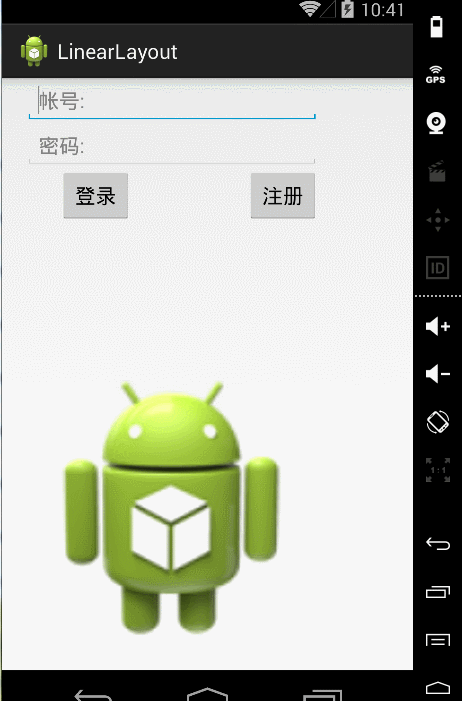Android 布局学习之——Layout(布局)具体解释二(常见布局和布局參数)
[Android布局学习系列]
1.Android 布局学习之——Layout(布局)具体解释一
2.Android 布局学习之——Layout(布局)具体解释二(常见布局和布局參数)
3.Android 布局学习之——LinearLayout的layout_weight属性
4.Android 布局学习之——LinearLayout属性baselineAligned的作用及baseline
Layout Parameters(布局參数):
在XML文件里,我们常常看到类似与layout_width这种布局属性(layout attributes),这些属性用来定义
View的布局參数,为了让它适合于ViewGroup。
每一个ViewGroup类都实现了一个继承自ViewGroup.LayoutParams的嵌套类。
子类包括定义每一个子View大小和位置的属性类型,为了适应于ViewGroup。
以下通过官方文档的一张图片以及一个XML文件来学习一下:

1 <!-- activity的根布局是LinearLayout 也就是线性布局 -->
2 <LinearLayout xmlns:android="http://schemas.android.com/apk/res/android"
3 xmlns:tools="http://schemas.android.com/tools"
4 android:layout_width="match_parent"
5 android:layout_height="wrap_content"
6 android:background="#0f0"
7 android:orientation="vertical" >
8 <!-- LinearLayout有个子View是RelativeLayout -->
9 <RelativeLayout
10 android:layout_width="wrap_content"
11 android:layout_height="wrap_content"
12 android:background="#f00"
13 >
14 <TextView
15 android:id="@+id/textView1InRL"
16 android:background="#fff"
17 android:layout_width="wrap_content"
18 android:layout_height="wrap_content"
19 android:text="TextView" />
20
21 <TextView
22 android:id="@+id/textView2InRL"
23 android:background="#fff"
24 android:layout_width="wrap_content"
25 android:layout_height="wrap_content"
26 android:text="TextView2"
27 android:layout_toRightOf="@id/textView1InRL"
28 />
29 <TextView
30 android:background="#fff"
31 android:layout_width="wrap_content"
32 android:layout_height="wrap_content"
33 android:text="TextView3"
34 android:layout_below="@id/textView2InRL"
35 />
36 </RelativeLayout>
37 <Button
38 android:text="Button1InLinearLayout"
39 android:layout_width="wrap_content"
40 android:layout_height="wrap_content"
41 />
42 <Button
43 android:text="Button2InLinearLayout"
44 android:layout_width="wrap_content"
45 android:layout_height="wrap_content"
46 />
47 </LinearLayout>

从上,我们能够看出。布局中的子元素都必须定义使他合适于它的父布局的布局參数,虽然它可能为它的子元素定义不同的布局參数。比方上图中的RelativeLayout,它受父Layout:LinearLayout影响,然后它的布局參数则影响到了它的子元素:三个TextView。
常见的布局(Common Layouts):
以下介绍Android中经常使用的布局:
1.线性布局(Linear Layout)
将子元素按垂直方向或水平方向线性排列。(假设窗体的长度超过了屏幕的长度,则能够生成一个滚动栏)
窗体长度超过屏幕长度,生成滚动栏(srollbar)的方法:
用ScrollView包裹线性布局:

1 <LinearLayout
2 android:layout_width="fill_parent"
3 android:layout_height="fill_parent"
4 xmlns:android="http://schemas.android.com/apk/res/android">
5 <ScrollView
6 android:layout_width="fill_parent"
7 android:layout_height="wrap_content">
8 <LinearLayout
9 android:layout_width="wrap_content"
10 android:layout_height="wrap_content"
11 android:orientation="vertical">
12 <!-- 这里放线性布局中的内容 -->
13 </LinearLayout>
14 </ScrollView>
15 </LinearLayout>

通过一个样例来深入学习一下线性布局:

1 <LinearLayout xmlns:android="http://schemas.android.com/apk/res/android"
2 xmlns:tools="http://schemas.android.com/tools"
3 android:layout_width="match_parent"
4 android:layout_height="wrap_content"
5 android:paddingLeft="20dp"
6 android:paddingRight="20dp"
7 android:orientation="vertical" >
8 <ScrollView
9 android:layout_width="fill_parent"
10 android:layout_height="wrap_content"
11 >
12 <LinearLayout
13 android:layout_width="wrap_content"
14 android:layout_height="wrap_content"
15 android:orientation="vertical"
16 >
17 <EditText
18 android:layout_width="match_parent"
19 android:layout_height="wrap_content"
20 android:hint="帐号:" />
21 <EditText
22 android:layout_width="match_parent"
23 android:layout_height="wrap_content"
24 android:hint="password:" />
25 <LinearLayout
26 android:layout_width="wrap_content"
27 android:layout_height="wrap_content"
28 android:orientation="horizontal"
29 >
30 <Button
31 android:layout_width="wrap_content"
32 android:layout_height="wrap_content"
33 android:layout_marginLeft="30dp"
34 android:text="登录"
35 />
36 <Button
37 android:layout_width="wrap_content"
38 android:layout_height="wrap_content"
39 android:layout_marginLeft="100dp"
40 android:text="注冊"
41 />
42 </LinearLayout>
43 <ImageView
44 android:layout_width="match_parent"
45 android:layout_height="500dp"
46 android:src="@drawable/ic_launcher"
47 />
48 <TextView
49 android:layout_width="match_parent"
50 android:layout_height="wrap_content"
51 android:text="LinearLayout大小超过屏幕大小的測试"
52 />
53 </LinearLayout>
54 </ScrollView>
55 </LinearLayout>


2.相关布局(Relative Layout)
正如其名,相关布局。我们能够通过让子元素互相相关(比方Button A在TextView B的以下)或与父母相关来指定
它们的位置。
默认地,全部的子View都被放置在布局的左上方(top-left)。
设置子View之间和子View与父母之间关系的參数例如以下图所看到的:
相同通过一个样例来学习一下相关布局:

1 <RelativeLayout xmlns:android="http://schemas.android.com/apk/res/android"
2 xmlns:tools="http://schemas.android.com/tools"
3 android:layout_width="match_parent"
4 android:layout_height="match_parent"
5 tools:context=".MainActivity" >
6
7 <!--android:layout_centerHorizontal 设置TextView在水平中心-->
8 <TextView
9 android:id="@+id/login"
10 android:layout_width="wrap_content"
11 android:layout_height="wrap_content"
12 android:layout_centerHorizontal="true"
13 android:textSize="20sp"
14 android:text="登录界面" />
15 <!--android:layout_marginTop="24dp" 设置了EditText的顶部上面的空暇空间是24dp -->
16 <EditText
17 android:id="@+id/editText1"
18 android:layout_width="wrap_content"
19 android:layout_height="wrap_content"
20 android:layout_below="@id/login"
21 android:layout_centerHorizontal="true"
22 android:layout_marginTop="24dp"
23 android:hint="username"
24 android:ems="10" >
25
26 <requestFocus />
27 </EditText>
28 <!-- android:layout_below="@+id/editText1"editText2在editText1以下 -->
29 <EditText
30 android:id="@+id/editText2"
31 android:layout_width="wrap_content"
32 android:layout_height="wrap_content"
33 android:layout_below="@+id/editText1"
34 android:layout_centerHorizontal="true"
35 android:layout_marginTop="27dp"
36 android:ems="10"
37 android:hint="password"
38 android:inputType="textPassword" />
39 <!-- android:layout_alignRight="@id/editText2"设置cancelButton与
40 editText2的右边缘对齐-->
41 <Button
42 android:id="@+id/cancelButton"
43 android:layout_width="wrap_content"
44 android:layout_height="wrap_content"
45 android:layout_below="@id/editText2"
46 android:layout_alignRight="@id/editText2"
47 android:text="取消"
48 />
49 <!-- android:layout_toLeftOf="@id/cancelButton"设置确定button在取消button的左边 -->
50 <Button
51 android:id="@+id/confirmButton"
52 android:layout_width="wrap_content"
53 android:layout_height="wrap_content"
54 android:layout_below="@id/editText2"
55 android:layout_toLeftOf="@id/cancelButton"
56 android:text="确定"
57 />
58
59 </RelativeLayout>

希望这篇文章对大家的学习有所帮助,假设你喜欢,请推荐一下,谢谢~
假设转载,请在文章开头处注明本博客地址:http:www.cnblogs.com/JohnTsai
欢迎讨论交流,邮箱:JohnTsai.Work@gmail.com :)
Android 布局学习之——Layout(布局)具体解释二(常见布局和布局參数)的更多相关文章
- Android 布局学习之——Layout(布局)详解二(常见布局和布局参数)
[Android布局学习系列] 1.Android 布局学习之——Layout(布局)详解一 2.Android 布局学习之——Layout(布局)详解二(常见布局和布局参数) 3.And ...
- Android 布局学习之——Layout(布局)详解一
layout(布局)定义了用户界面的可视化结构(visual structure),如Activity的UI,应用窗口的UI. 有两种方式声明layout: 1.在xml文件中声明UI组件. 2.在运 ...
- android选择图片或拍照图片上传到server(包含上传參数)
在9ria论坛看到的.还没測试,先Mark与大家分享一下. 近期要搞一个项目,须要上传相冊和拍照的图片.不负所望,最终完毕了! 只是须要说明一下,事实上网上非常多教程拍照的图片.都是缩略图不是非常清晰 ...
- Swift自适应布局(Adaptive Layout)教程(二)
给TextContainer中添加内容 打开 Main.storyboard ,从组件库(Object Library)中拖拽两个 Label 组件到TextContainer中,位置可以随意摆放: ...
- Android开发学习之TabView选项卡具体解释 -- 基于Android4.4
版权声明:本文为博主原创文章,未经博主同意不得转载. https://blog.csdn.net/he90227/article/details/24474197 直接上代码 -- 基于Android ...
- Android布局学习——android:gravity和android:layout_gravity的区别
[Android布局学习系列] 1.Android 布局学习之——Layout(布局)详解一 2.Android 布局学习之——Layout(布局)详解二(常见布局和布局参数) 3.And ...
- Android签名机制之---签名验证过程具体解释
一.前言 今天是元旦,也是Single Dog的嚎叫之日,仅仅能写博客来祛除寂寞了,今天我们继续来看一下Android中的签名机制的姊妹篇:Android中是怎样验证一个Apk的签名. 在前一篇文章中 ...
- 14.Android之Layout布局学习
Android布局主要有5种,接下来学习总结下. 1) 最常见的线性布局 LinearLayout 线性布局是Android布局中最简单的布局,也是最常用,最实用的布局. android:orient ...
- Android Animation学习(五) ApiDemos解析:容器布局动画 LayoutTransition
Android Animation学习(五) ApiDemos解析:容器布局动画 LayoutTransition Property animation系统还提供了对ViewGroup中的View改变 ...
随机推荐
- 设计师给了px显着的单位,Android要设置多少开发商dip、dp、sp?
此链接 http://blog.csdn.net/xiaodongrush/article/details/29560431 1. 要开发一款Android APP,设计师和开发要约定哪些事情? ...
- Xcode 5.1.1 与 Xcode 6.0.1 共存
Xcode 5.1.1 (下面简称Xcode5)和Xcode 6.0.1(下面简称Xcode6)都是正式版本号.其应用程序文件名称都是"Xcode".假设通过AppStore升级或 ...
- Mono for Android开发调研笔记
安装完Mono for Android(简称:MonoDroid)之后,可以用MonoDevelop或Visual Studio来开发Mono for Android应用程序:目前只能在模拟器上调试和 ...
- GUI (图形界面)知识点
一:组件知识点 JTextField: 作用: 定义文本域,只支持单行输入. 使用: 定义文本域: JTextField jtf=new JTextField ...
- java 加载dll介绍(转)
最近在做的工作要用到本地方法,需要在Java中加载不少动态链接库(以下为方便延用Windows平台下的简写dll,但并不局限于Windows).刚刚把程序跑通,赶紧把一些心得写出来,mark.也希望对 ...
- 1!到n!的和
Time Limit: 1 Sec Memory Limit: 64 MB Submit: 23 Solved: 14 [Submit][Status][Web Board] Descriptio ...
- 玩转Web之JavaScript(四)-----javaScript语法总结(四) JS中的函数
1.function/return function用来定义函数(位于head部分),函数包含着一些代码,这些代码只能被事件激活,或者在函数被调用时才会执行. return 用来从函数中返回值 ...
- JAVA学习笔记 -- 包资源文件jar包裹
初学者GUI,使用Eclipse出口jar包裹,不能显示最小化的图标集(hello.png根文件下的项目文件夹文件).码如下面: import javax.swing.JFrame; import j ...
- 鸟哥Linux私房菜知识汇总8至9章
一看最近<鸟哥Linux私房菜>. 这是一个基本的书,万丈高楼平地起,学. 这是我整理的一些知识点.尽管非常基础. 希望和大家共同交流. 第8章 Linux磁盘与文件系统管理 一.Linu ...
- Oracle Net Listener Parameters (listener.ora)(转)
12/20 7 Oracle Net Listener Parameters (listener.ora) This chapter provides a complete listing of th ...
